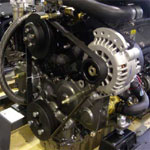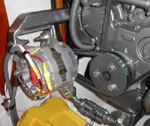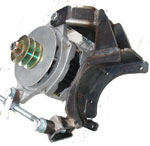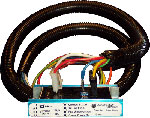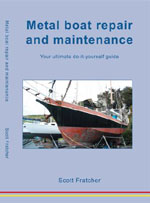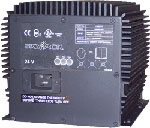Frequently Asked Questions
What size battery bank should you have?
If you are a cruiser the answer to this one is quite simple - The largest
one you can afford in terms of space, weight and money. This is equally
true no matter what the electrical load is! To see why, let's take a
look at two different approaches to estimating the "correct"
battery capacity.
Energy Analysis - the conventional wisdom.
It is common practice among the energy gurus to perform an energy analysis
of a cruising boat and advise a battery bank capacity based on the results.
To perform such an analysis, assumptions are made about the length of
time the lights, appliances, navigational equipment, water maker, etc.
will be operating and the amount of current they will draw while they
are on. An amp-hr (current draw x operating time) total over a 24 hour
period is then calculated for every device which consumes electrical
energy.
For example;
Usage per 24 hrs
Three reading lights drawing 1 amp each will be used an average of 3.5
hours per day.
(3 x 1) x 3.5 = 10.5
10.5 amp-hrs
The refrigerator draws 6 amps while it's running and runs an average
of 18 hrs per day.
6 x 18 = 96
96 amp-hrs
Making accurate estimates for some items is relatively easy, for others
such as electric autopilots it is nearly impossible. Nevertheless, to
complete the analysis, the total estimated energy consumption of all
such devices is added together to provide an estimated average total
daily energy consumption in amp-hrs. As you can imagine, the totals
vary tremendously from boat to boat. However, for illustration purposes,
let's assume that our particular cruiser calculates a total estimated
use of 140 amp-hrs per 24 hours.
In the next step of the analysis it is assumed that our cruiser will
not want to discharge their batteries more that 50% since it is commonly
believed that doing so will disproportionately shorten their life span.
The cruiser must now decide how often they wish to run their engine
or generator recharge their batteries. This, in combination with their
estimated daily energy consumption then forms the basis for calculating
the battery bank size required.
For example;
Recharge Frequency Desired
Bank Size Required
twice per day
140 amp-hr
once per day
280 amp-hr
once every two days
560 amp-hr
once every three days
840 amp-hr
So it is seen that, by using the energy analysis method, the calculation
of appropriate battery bank size is made purely on the basis of energy
usage and the frequency of recharge cycles.
Sounds good. So what's the problem?
Why energy consumption is irrelevant when sizing your battery bank.
While it can be helpful to have an idea of how much energy you are likely
to use in a day, it should not form the basis for sizing your battery
bank. Why? Because it leaves out the single most important consideration
in battery bank sizing - the recharge, or acceptance, rate. The energy
consumption analysis gives you an idea of how often you will need to
run your charging engine but gives no indication of how long the engine
will need to be run. For most cruisers, particularly those who have
already had the experience of sitting in their island paradise amidst
the diesel fumes waiting for their batteries to recharge, minimizing
their engine run time is the top priority.
The proper size alternator for the battery bank.
To fully appreciate why the acceptance rate is so important it is first
necessary to gain an understanding of the relationship between alternator
size battery bank size. It is only possible to select right alternator(s)
after the capacity and type of battery bank have been determined.
Capacity -
While the power output of a battery is rated in several ways, the only
rating generally useful to the cruiser also happens to be the most common
and is referred to as the 20 hour amp-hr rating. This number represents
the total amount of energy that the fully charged battery can release
when discharged at a stable rate over a 20 hour period. A good quality
8D size (20"x11"x10") lead-acid type deep cycle battery
would have a 20 hour rating of 220 amp-hrs @ 12 volts. Gelled electrolyte
type batteries (gel cells) and absorbed glass mat batteries (AGM) are
usually slightly less with about 200 amp-hrs in an 8D size. Remember,
when determining the capacity of your battery bank use the manufacturers
ratings and add the amp-hr rating of all batteries which are connected
in parallel and discharged and recharged as a single bank. If you choose
to use multiple house banks (not recommended) count only those banks
which are discharged and recharged simultaneously. Do not simply add
up the ratings of all the batteries on your boat.
Type -
This is not a question of brand name but one of electrolyte type. Your
choice here is common lead-acid, gelled lead-acid (gel cell) or absorbed
glass mat (AGM).
Calculating your battery bank's acceptance rate.
The acceptance rate is the maximum rate at which a battery bank can
be recharged. The acceptance rate of the bank is determined by it's
capacity, type and state-of-charge. Since we know (or can determine)
the capacity and type of the bank, we will need to make an assumption
as to it's average state of charge under cruising conditions. Batteries
which are deeply discharged have a higher acceptance rate than those
which are more fully charged. Surveys have shown that cruisers typically
cycle their batteries between 50% and 80% of full charge under most
conditions. Cruisers who have large capacity banks in comparison to
their energy needs tend to cycle between 70% and 90%, while those with
small banks tend to cycle between 40% and 70%.
For the sake of this exercise, we will estimate at the average acceptance
rate when cycling the batteries between 50% and 80% of full charge.
Under these conditions lead-acid batteries have been shown to have an
acceptance rate equal to 25% of their total 20 hour amp-hr rating. Stated
another way, a lead-acid battery bank consisting of three 8D size 12
volt batteries @ 220 amp-hrs each (660 amp-hrs total) would have an
acceptance rate of 165 amps.
One advantage in gel cell type batteries is that they have a higher
acceptance rate than do the common lead acid type. Acceptance rate calculations
made with gel cell batteries should be based on 40% of their 20 hour
amp-hr rating rather than the 25% figure used with lead acid.
Because of their lower 20 hour rating, the bank of three 8D batteries
described in the example above would have a total capacity of only 600
amp-hrs (rather than 660 with lead acid). However, they would have an
acceptance rate of 240 amps instead of 165 amps.
The highest acceptance rate is obtained with absorbed glass mat batteries
(AGM). Acceptance rate calculations made with AGM batteries should be
based on 100% of their 20 hour amp-hr rating rather than the 25% figure
used with lead acid or 40% used with gel cells. Our bank of three 8D
batteries (as described in the other examples) would have a total capacity
of 600 amp-hrs just as would the gel cells. However, they would have
an incredible acceptance rate of 600 amps instead of 165 amps (lead
acid) or 240 amps (gel cell).
As you can see, once you know the capacity and type of your battery
bank you can calculate it's acceptance rate. Simply multiply the total
capacity by 25% for lead acid batteries, 40% for gel cells or 100% for
AGMs.
What about the alternator?
Since the acceptance rate described the maximum rate at which a battery
bank can be recharged, it stands to reason that the proper size alternator
can only be selected once the acceptance rate has been determined. It
is wasted money to charge a battery bank that has an acceptance rate
of 70 amps with a 165 amp alternator. Likewise, using a 100 amp alternator
to charge a battery bank with an acceptance rate of 240 amps is pointlessly
slow and inefficient. The goal is to get the output of your alternator
(under actual charging conditions) to match the acceptance rate of your
battery bank as closely as possible. Most alternator manufacturers will
provide you with the output curve of the alternator you are considering
under hot conditions and at a variety of speeds. An alternator rated
at 150 amps will likely only put out 130 amps once it gets hot and will
only do that running at full speed. Under realistic charging conditions,
you may only be running your engine at 1100 - 1200 rpms. If your alternator
is belted at a 2 to 1 ratio it will be spinning at twice that speed,
or 2200 - 2400 rpms. It is quite possible that 150 amp alternator is
now only going to putting out 80 amps or so.
Given this, how is it possible to get 200 to 300 amps of real charging
capability? Sometimes it isn't, but don't give up too quickly. Very
large alternators with outputs 200+ amps are now quite common. Additionally,
it is often very practical to use two or more alternators to charge
a single bank. Some boats are already set up to have one alternator
charge the engine start battery and a second to charge the house bank.
Usually the engine start battery needs little if any charging. An automatic
battery bank combiner can be used to allow both alternators to charge
the house bank.
How much difference does this approach to battery sizing make?
Occasionally none, but often the results are surprising. Take a look
back at our very first example where our cruiser was required to replace
140 amp-hrs of energy per day. Let's assume that, using the energy analysis
approach, he determined that running the engine once per day would be
ok. He would then be advised to install a lead-acid battery bank of
280 amp-hrs capacity (ie. 50% max discharge).
Now, using your knowledge of acceptance rate calculation, you know
that the maximum rate at which this bank can be recharged 70 amps (bank
capacity x 25%). Therefore, it will take two hours of engine run time
per day to replace the electricity that the cruiser is using (70 amps
x 2 hours = 140 amp-hrs).
If, on the other hand, the cruiser wants to minimize their engine run
time, they could increase their battery bank to far in excess of that
recommended by the energy analysis approach to, say 600 amp-hrs. With
this bank the acceptance rate would now be 150 amps, making it possible
to replace the same 140 amp-hrs in less than one hour, or only ½
the time required by the smaller bank. If all that sounds great but
you don't have room for that many batteries, use gel cells or AGMs.
You'll be able to get that high charge acceptance rate in a much smaller
bank.
By gaining a good understanding of battery acceptance rates, it is
clear how large house battery banks can be used to reduce the engine
run time. It is equally easy to see why the popular practice of separating
house batteries into multiple banks is not the most efficient use of
energy.
Battery life.
One cannot really discuss "battery life" without first defining
the term. The same energy gurus who promote the energy analysis method
of battery bank sizing usually describe battery life by the number of
cycles (ie. discharge and recharge) which can be done before the battery
fails. Through their efforts, most people now recognize that depth of
discharge has a direct impact on the number of discharge/recharge cycles
a battery can do. As a result, many cruisers endeavor to cycle their
batteries as "shallowly" as possible.
However, the number of cycles is only one measure of a battery's life
and probably not the best. Another way to look at battery life is by
looking at the total number of amp-hrs which a battery will store before
failure. When viewed in this way, quite a different picture emerges
as can be seen in the chart below.
From our previous look at acceptance rate we know that batteries can
be recharged much faster when they are permitted to cycle down to 50%
and below. From this chart it is obvious that doing so extends the useful
life of the batteries as well.
Conclusion.
By first calculating how much energy your system will use, and then
applying the principles discussed in this paper to your battery and
charging system, you will see just how much better off you are with
the DC system rather than an direct engine-drive. For those who do not
mind engine running, there is still a place for engine-driven refrigeration.
However, as you will see once your calculations are complete, they rarely
make sense on a cruising sailboat. Correctly set up, your DC system
will typically require 1/2 to1/4 the daily engine run time of an engine-driven
system. By properly planning and setting up your DC system, and combining
it with energy efficient appliances such as refrigeration and watermakers,
battery charge concerns really can become a thing of the past.
Battery Care and Maintenance.
Here's some information from Electromaax, a full supplier of new electrical
products for the starting and charging of Marine equipment.
"A good battery can provide four or five years of worry-free service
with the right kind of care. But, batteries can also die out fast, in
less than six months, if they are neglected.
1. It is very necessary in order to keep a healthy battery, that the
charge rate be maintained within the recommended boundaries.
2. If neglected, the electrolyte level becomes very low, and the battery
starts to lose power, since part of each plate is above the water line.
* This keeps the rest of plate overworked.
* Tops of the plates exposed to air start to dry out and harden. Once
this happens, the plates will lose most of their ability to accept a
charge and produce electricity.
3. Lead acid batteries generally require adding water about twice
a year.
4. Electrolyte level should be maintained about a quarter inch above
the tops of the battery plates.
Outside the Battery
1. The outside of the battery is just as important as the inside.
For example, dirt or acid salts can build up on top of the battery.
A conductive layer is formed causing a constant discharge drain on the
cells.
2. A baking soda bath with water and dish detergent, 3 times per year,
helps keep outside battery losses at a minimum. Never allow this mixture
to enter the battery. This mixture will neutralize acid and cause dead
cells.
3. Corrosion of the cable terminals is a major cause of battery problems.
(Spraying Corrosion Block here can help)
* a. Acid corrosion can greatly destroy the cable and result in loss
of current to the starter.
4. Check all terminals to see that they are absolutely clean and tight.
Check for broken wires at battery cable connections.
5. Proper care of cables and terminals is as important as maintaining
the battery.
6. Never store a battery for more than 30 days without recharging,
or store a battery for any length of time in a discharged state. Sulfation
starts when a battery becomes discharged. Sulfation is normal.
When sulfation happens, lead sulfate is formed from the self-discharge
of the plates or the plates standing in a discharged state for a long
period of time. Hard, bulky, crystal-like substances are created on
the plates.
You must have a charger with a "EQ" Equalize Button, when
you Equalize the battery you in essence over charge it (15.5 volts)
to break down the sulfides deposits on the plates, thus giving the battery
more life and the ability to hold it's original rated charge. The Equalize
Mode is a controlled overcharge used periodically (example, once each
month or once every other month) to help dissolve any recently solidified
sulfate deposits on the battery plates. Older sulfation deposits normally
harden onto the plates, and cannot be dissolved into the electrolyte.
Batteries that are in a discharged state for too long and are not being
used, will lose the balance of their charge. It is not recommended that
a battery go for more than 30 days without getting a charging current.
What also happens, is that the pores of the active materials get clogged
from the large bulky crystals of sulfate. The active material gets pushed
out of the grids, causing them to buckle. If too much internal expansion
happens from a sulfated battery, the case will become bulged or cracked.
**WARNING** Batteries give off hydrogen gas constantly. Hydrogen gas
is highly explosive. Always wear safety glasses or goggles and use caution
when working with batteries.
Battery Testing: Open Circuit Voltage Test
Before you can properly test any battery it must be fully charged.
You can verify the state of charge two ways: (Doing Both is Recommended)
The simplest test is done with a digital multimeter.
The other test involves the use of a hydrometer.
Using the digital multimeter to verify the state of charge:
A fully charged 12 volt battery will read at least 12.6 volts on the
multimeter when connected as shown below.
Open Circuit Volts? Percent, with no loads or chargers connected.
11. 7 volts or less? 0%
12.2???? 50%
12.4???? 75% 12.6 or more??100%
Digital multimeter will read 12.6 volts on a fully charged 12 volt
battery.
(2.1 volts per cell times "6 cells" = 12.6 volts)
Connect the digital multimeter to the battery terminals. If your reading
is 12.4 or below you must recharge the battery before testing.
Using a hydrometer to verify the state of charge:
When testing batteries with removable filler caps, the hydrometer can
be a very useful tool. Always use protective acid resistant gloves and
safety glasses or a full face shield.
Each cell of the battery can be individually tested for state of charge.
A reading of 1.250 is usually considered good. (See hydrometer below.)
If a cell is found with specific gravity below 1.150 the battery is
considered dead. When one or more of the cells produces a reading that
is .050 or more below that of the others, it's a pretty good indication
that the low cells are shorted. If all the cells read below 1.250 then
the battery must be recharged before testing.
State of Charge - ? Standard Specific Gravity
100% charged?- ?1.270
75% charged - ?1.225
50% charged - ?1.190
25% charged - ?1.155
Discharged - ??1.120
Warranty Information
LIMITED PRODUCT WARRANTY
ELECTROMAAX warrants to the original consumer/purchaser the product
is free from any defects in material or workmanship for a period of
one year from the date of purchase. If any such defect is discovered
within the warranty period, ELECTROMAAX will replace the defective part
free of charge, subject to verification of the defect or malfunction
upon delivery or shipping prepaid to ELECTROMAAX.
This warranty DOES NOT apply to defects or physical damage resulting
from abuse, neglect, accident, improper repair, alteration, modification,
or unreasonable use of the products resulting in breakdown, cracked
or broken housings nor are parts damaged by fire, water, freezing, collision,
theft, explosion, rust, corrosion or items damaged in shipment enroute
to ELECTROMAAX for repair. ELECTROMAAX assumes no responsibility for
consequential damage or loss or expense arising from these products
or any labor required for service or repair.
ELECTROMAAX WILL NOT repair or be held responsible for any product sent
without proper identification, return address and Return Authorization
(RA) number clearly marked on the package. You must include proof of
date and place of purchase (photocopy of purchase invoice) or we cannot
be responsible for repairs or replacement. In order to expedite warranty
claims more efficiently, ELECTROMAAX asks that prior to returning a
defective product for repair, you call ELECTROMAAX 's Customer Service
department for a warranty return authorization number.
If factory service is required, you can contact our ELECTROMAAX Customer
Service Department Monday through Friday, 8:30 AM to 5:00 PM, (EST)1-866-945-8801.
Material required for the repair or replacement for the defective part
or product is to be supplied free of charge upon delivery of the defective
product to ELECTROMAAX, 3083 Grassie Road, Grassie, Ontario, Canada,
L0R-1M0. Customer is responsible for all return transportation charges
and any air or rush delivery expense. ELECTROMAAX reserves the right
to determine whether to repair or replace defective components. Returned
warranty or non-warranty items deemed non-repairable will be disposed
of after 30 days, unless claimed by owner. ELECTROMAAX is not liable
for damage to or loss of returned items.
THE ABOVE LIMITATIONS MAY NOT APPLY TO YOU. SOME PROVINCES AND STATES
DO NOT ALLOW LIMITATIONS ON HOW LONG AN IMPLIED WARRANTY LASTS. NO PERSON,
AGENT, DEALER IS AUTHORIZED TO GIVE ANY WARRANTY.
We fit most production boats
Beneteau 43 use a JH4 reverse mount with a large frame Delco
Beneteau 47 and Beneteau 50 alternator upgrade use a JH4-TE reverse
mount with a large frame Delco
Hanse yachts use an pulley kit
Hanse yachts with a YM30 use a pulley kit, or a YM30 second alternator
kit.
Jeanneau yachts tend to use a reverse mount to the Yanmar engine, but
can also use a pulley kit
Norsman 447 use a 4JH4-TE reverse kit
Lagoon and other cats use a forward facing kit
Email with your boat's details for more
information
We have kits to fit other Yanmar engines Please
contact us For More Information
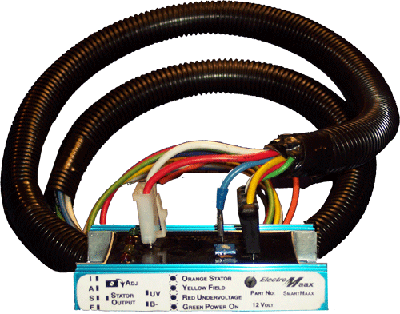
Need a well thought out economical three step regulator? Check out
the Electro Maax regulator here.

Want more amperage? Limited space? Check out our Yachtwork line of
second alternator kits here.
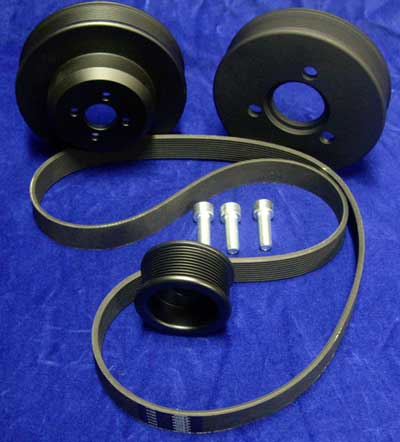
Tight on space? Can only fit one alternator but still want the big
amperage? Try one of our Electro Maax pulley kits here.
|

